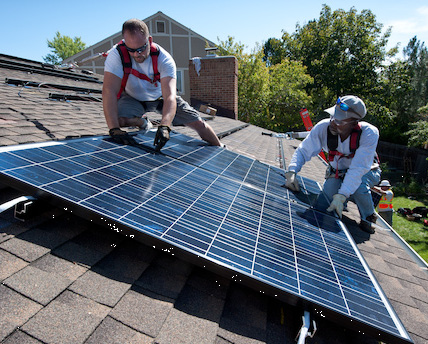Installing rooftop solar panels has never been more affordable. UCS’s new solar infographic highlights the remarkable drop in the cost of rooftop solar in recent years, and how people are getting systems for even less, or even for zero dollars down. Here’s how the numbers add up (or down), and why—and how you can get in on the action.
As we show in the infographic and our new Solar Power on the Rise report, prices for household solar photovoltaic (PV) systems started dropping around 2009, and fell by almost 30 percent from 2010 to 2013. They went from an average of around $32,000 for a five-kilowatt system to under $23,000 — before tax credits or other incentives.
Getting below $10,000
But the price drops don’t stop there. Homeowners and others can take advantage of a federal tax credit that sends 30 percent back to you at tax time.
At least 45 states and Washington, D.C., also have state tax incentives for homeowners and businesses, and some local governments offer additional incentives, like property tax exemption. Some states have rebates, and some have solar carve-outs in their broader renewable electricity standards that offer solar system owners a chance for additional revenue.
All told, in leading states, the price drops and combination of incentives mean that an installed system could cost less than $10,000—a far cry from what solar was costing just a few years ago. And it means that some people are seeing payback periods of as little as 4 to 6 years.
Why solar costs are falling
There are several factors for the price drop:
- Economies of scale is a big one. Global solar panel production (for rooftop and other markets) grew from 24,000 megawatts (MW) in 2010 to 40,000 MW in 2013 — a 67 percent increase in just three years. China has also come on the scene in a big way in recent years, which has lowered market prices.

Source: National Renewable Energy Laboratory
- Reductions in “soft” costs, is another important piece. Soft costs are those associated with things like sales and marketing, local permitting, and hookup to the local electricity grid — and even how much profit installers make on a given transaction. Many of these pieces are related to economies of scale, too: more systems in a given area means some fixed or first-time costs (advertising, or introducing a local inspector to rooftop solar) can get spread over a larger customer base.
What all that means is that, in more than half of U.S. states, solar could be at or near the point of “grid parity,” where power from a system on your roof could cost about the same as what you get from your electric utility. (Check out my colleague Mike Jacobs’ thoughts on solar grid parity.)
How about zero dollars down?
Another way that solar has been becoming much more accessible is through innovative ownership structures, particularly leases or power purchase agreements. Leases aren’t new — auto dealers and customers make good use of them — but in recent years they’ve taken the solar world by storm.
Under these types of arrangements, you might be able to pay little or nothing up front to get solar on your roof, then pay a monthly fee or pay for the solar electricity each month based on how much it actually produces.
As with the lease/buy decision that people make when they’re on the market for a car or truck, those types of deals won’t be for everyone. But it turns out that a lot of people are pretty keen on the idea: third-party-owned arrangements account for two-thirds of new home systems.
How do I get a piece of the action?
So how do you get in on the fun, take charge of your electricity bill, push for a cleaner energy future, and maybe end up with a great investment? Here are a few ideas:
- Check out incentives. The DSIRE website is a great resource for all kinds of energy (and efficiency) rebates and incentives, including ones for solar.
- Ask your neighbor. If someone you know has gotten solar, find out what you can about where and under what terms he/she got it.
- Call around. See what solar suppliers in your area can offer, in terms of systems and products, plus financing.
- Read Solar Power on the Rise. Okay, so it might not actually get you in on the fun, but it’s a quick read and it’ll give you a better sense of the technologies, the issues, and the opportunities.
As our solar infographic helps show, there’s a revolution happening, and it’s worth looking into.

